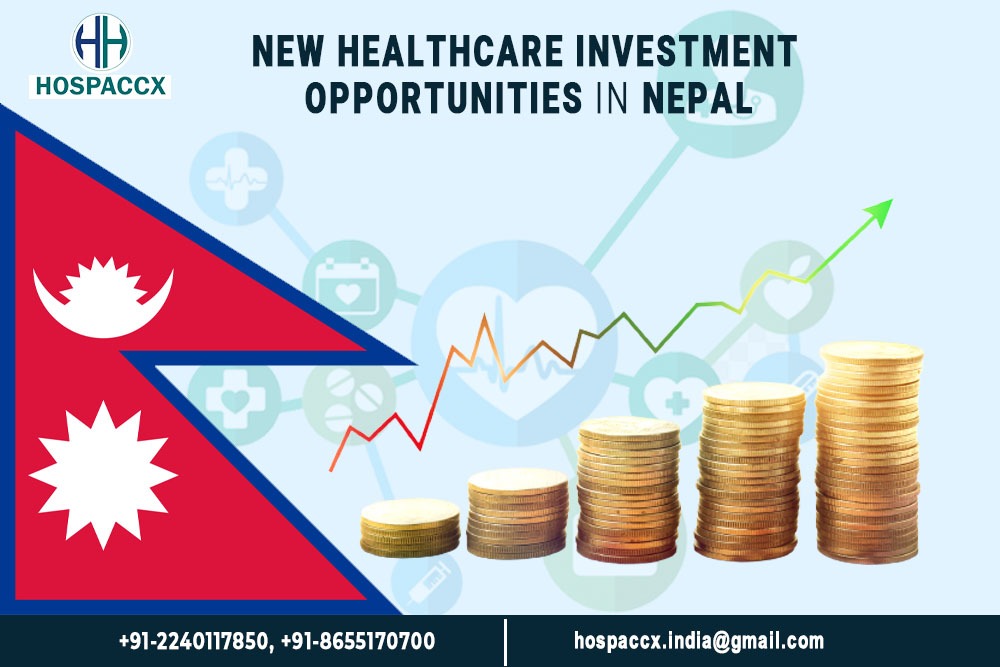Nepal is strategically located between India and China, two of the largest economies in the world. In 2015, the country adopted a new constitution that embraces multiparty democracy, federalism and private sector-led liberal economics. The government is committed to the promotion of foreign investment, providing a unique opportunity for foreign direct investment (FDI) in Nepal.
Although Nepal is classified as a least developed country (LDC) by the United Nations, its goal is to graduate from this status by 2022 and transition to a middle income country by 2030, which it can do by leveraging its investment potential especially in the healthcare market. The global medical tourism market was valued at approximately USD 15.5 billion in 2017 and is expected to generate revenue of around USD 28.0 billion by the end of 2024, growing at a CAGR (compound annual growth rate) of around 8.8% between 2018 and 2024. Nepal has an immense potential to be developed as a global hub for specialised medical tourism services, with areas such ophthalmology already receiving tremendous success.
Economic and Financial Snapshot of Healthcare in Nepal
In 2019, health expenditure in Nepal amounted to approximately 4.45 percent of the country’s gross domestic product (GDP). Per capita government spending has gradually increased from Nepali Rupees (NPR) 1072 (USD 10.8) in FY 2014/15 to NPR 2295 (USD 20.2) in FY 2018/19 in real terms. However, in constant terms (base year fixed to FY 2000/01), within the same time, the per capita government health spending has increased very little, from NPR 394 (USD 4) to NPR 664 (USD 5.8).
Nearly 55% of Nepal’s healthcare expenditures are direct outlays by households, as compared to the global average of only 18%. One of the reasons for the high rate of “out of the pocket” expenditures can be attributed to rising disposable incomes (due to remittances) and the consuming population’s increased awareness about health and wellbeing.
health service management in nepal
Current health expenditure (CHE) as a share of gross domestic product (GDP) has continuously increased from 2006 to 2016, mostly driven by out-of-pocket (OOP) spending. Government spending on health has remained low during the entire period. More than 10.7% of people, or a total of more than 3 million people, had a burden expenditure on health larger than 10% of their total expenses. Additionally, 1.67% of the population was pushed below the poverty line of PPP$ 1.90 per capita per day.
Healthcare Investment Opportunities
While a number of investment opportunities exist in the health care sector in Nepal, the pharmaceutical industry, health care facilities, ayurvedic medicines and ayurveda holistic treatment centres and health care educational services stand out.
Hospitals
While the Government of Nepal (GoN) is making more of an effort to increase the provision of primary and preventive health care, curative health care is dominated by the private sector service providers. The scope for the private sector lies principally in tertiary care and curative health care where there is scope for both general and specialised health care institutions.
There are nearly 3000 private healthcare enterprises in Nepal as of 2012. Most of these are diagnostic clinics. Other enterprises include primary clinics, secondary and tertiary hospitals and pharmaceutical companies. Most of the tertiary healthcare facilities in Nepal are multi-specialty with only a few focusing solely on one specialty. With only 0.36 doctors, 1.17 nurses and 0.9 hospital beds per 1,000 people, the demand supply gap can only be reduced with the addition of more health care facilities.
There are also opportunities for public private partnerships in the development and management of public health infrastructure. The GoN has indicated its receptiveness to proposals from the private sector to expand primary and secondary health care facilities.
Pharmaceuticals
A number of attractive investment opportunities can be found in medicine and health care supply manufacturing. Nepal’s population of approximately 28 million is a sizable market. To date, approx. 50% or more of this market has been met by way of imports. As such, there is scope not only for the production of the branded medicines but also for bulk drugs which provide the raw materials for medicines.
Strong Existing Infrastructure for Medicine Manufacturing
As of July, 2016 there are 37 pharmaceutical companies operating in Nepal. According to Association of Pharmaceutical Producers of Nepal (APPON), there are 45 pharmaceutical companies that are APPON registered, of which 37 who are-GMP certified.
Conducive Investment Environment
The GoN’s favourable policies, the existence of the domestic market and export potential, favourable WTO/TRIPS policy, restriction on imports without WHO/GMP Certification, and the rise in health care awareness among the people provide some added incentives for the investors to consider Nepal’s pharmaceuticals industry.
Ayurvedic Sectors
Ayurvedic medicine and treatment is popular among Nepali locals. At present Ayurveda health services are being delivered through 2 Ayurveda Hospitals (Naradevi, Kathmandu and Bijauri, Dang), 14 Zonal Ayurveda Aushadhalayas, 61 District Ayurveda Health centres and 305 Ayurveda Aushadhalayas in the country, which makes it an attractive investment potential.
Ayurvedic Medicines
In Nepal, the Ayurvedic drugs manufacturing sector is heavily fragmented. Recently, there have been some activities in organised, large-scale manufacturing from natural products like essential oils, roots and leaves mixed in specific ratios.
The original practices, manuscripts, records of Ayurvedic treatment, and medicinal use of abundant herbs continue to hold an important role in Nepal.
The country boasts approximately 7,000 species of plants, out of which approximately 700 species have medicinal properties. Many rare and endangered Himalayan herbs are found in Nepal’s higher elevations. The physical diversity of Nepal (Terai, Hilly and Himalayan region) allows sub-tropical, temperate and alpine vegetation all to flourish and to provide a source for a wide production. Many of these herbs and aromatic plants are specific to the Himalayan Region and have high medicinal, culinary and cosmetic values.
Ayurvedic Holistic Treatment Sector
The very fact that Nepal enjoys milder climatic conditions than the vast swaths of Indo Gangetic plains makes Nepal, a viable place to locate super specialty hospitals and nursing homes dealing in illness needing prolonged care attention of specialised professionals outside of modern towns. Apart from producing the ayurvedic treatments themselves, investors can also invest in Ayurveda Holistic Treatment Centers that provide the service of treatments with the Ayurveda discipline. The low competition in the sector with an untapped market and suitable climate for medicinal herbs make ayurvedic drugs an investment opportunity for the investors.
Healthcare Educational Services
Education and health are important enablers, where private sector involvement can help implement a key pillar of Nepal’s new growth strategy: investing in people and putting more human capital to productive use. In education, the private sector is playing an increasingly important role in technical and vocational education and training (TVET), and in tertiary education. According to the Council for technical and vocational education and training CTEVT, 47 colleges currently offer certificates of proficiency (PCL) in general medicine (HA) programs with an annual enrollment capacity of 1892. There are 19 medical colleges in the country, 8 colleges from Tribhuwan University (TU), 8 Kathmandu University (KU) affiliated colleges and 3 other colleges. These colleges produce 1,500 doctors annually.
Health Insurance
While for equity considerations public health insurance should remain the primary option, there is an opportunity for private health insurers. A major milestone in this regard was the passage of the National Health Insurance Act in 2017. First, there are untapped opportunities for the private sector to work with underserved populations through the national health insurance program. At the same time, there is also room to grow the private insurance market. Health insurance is a relatively new product in Nepal and firms have only penetrated 1 percent of the market. There are 17 licensed private health insurers in Nepal. All of them offer similar benefit packages covering major medical expenses (hospitalization), diagnostics, and drugs, but exclude preventative care. There are 20 contracted service providers/hospitals that dominate the private insurance market, and a few that have arrangements with Indian and international hospitals. The industry’s principal clients are global and large Nepalese companies (banks, manufacturers, telecoms) that offer health policies to their employees. However, the high-income and corporate segments have not yet been fully exploited.
Conclusion
In 2007, the Nepalese Government endorsed healthcare as a basic human right in its Interim Constitution. Despite this, only 61.8 percent of Nepalese have access to healthcare facilities within a 30-minute radius. Nepal also suffers from an inadequate supply of essential drugs and poorly regulated private healthcare providers. Statistically, Nepal also only has 0.67 doctors and nurses per 1,000 people. This is less than the World Health Organization’s recommendation of 2.3 doctors, nurses and midwives per 1,000 people. This indicates a growing need to invest in the healthcare sector of the country.
Although the concept to invest in the healthcare sector is new in Nepal, signs of progress are evident and a considerable amount of private sector activity can be seen in indicators of health outcomes including life expectancy, maternal care, and rates of communicable diseases. The Ease of Doing Business Index 2017 by the International Finance Corporation (IFC), World Bank Group places Nepal second only to Bhutan among all South Asian countries. Nepal’s investment potential, combined with these features, have led to an increase in interest in FDI in recent years.
While input and regulatory issues are binding, the health sector has a high potential development impact owing to the importance of human capital in inducing jobs and growth.
For more information about the Country and Healthcare opportunities in Nepal, you can visit the company website on www.hospaccxconsulting.com or contact us directly.
Related Team Members










